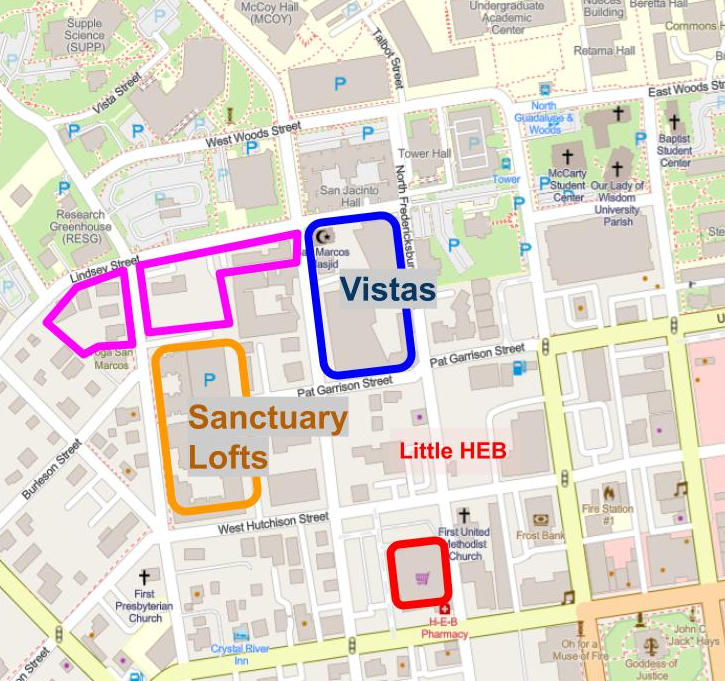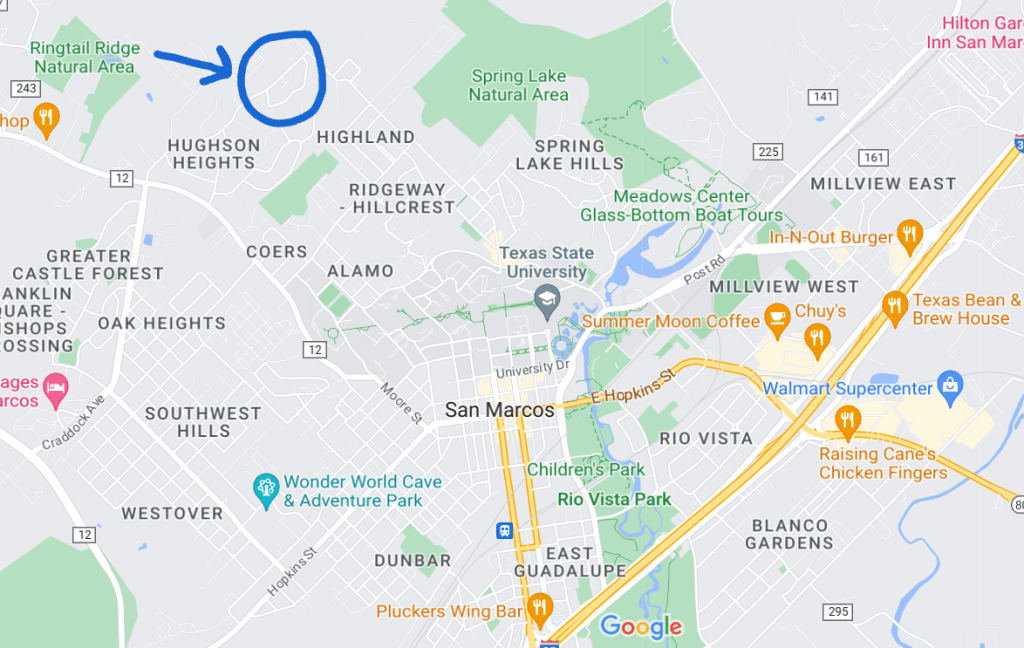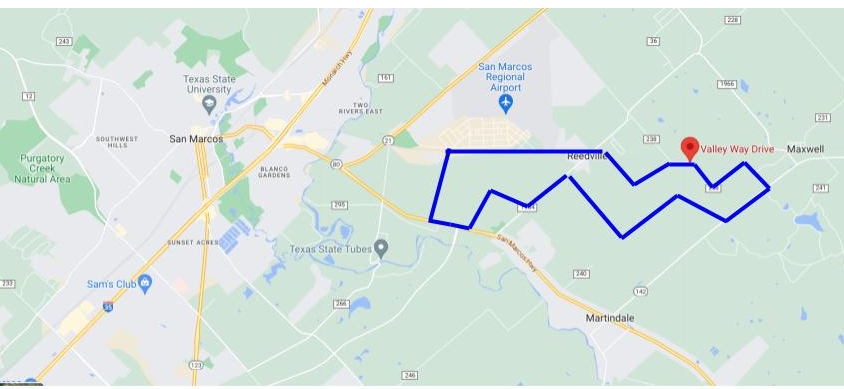We have to unpack this. The center of gravity has shifted on P&Z.
Let’s start with the end of the meeting: the committee voted on their new chair.
Jim Garber has been the chair of P&Z since 2016 (aside from one year when he cycled off P&Z). He’s literally been elected seven times. It’s been quite a run. Jim Garber was the main driving force behind the re-write of VisionSMTX.
But at this meeting, Garber lost re-election to David Case.
David Case is [updated: used to be] on the San Marcos Area Chamber of Commerce, and is the local VP for Schertz Bank. So it’s safe to say he’s pro-business. The pendulum has officially swung from anti-development towards pro-development.
Is this good or bad?
It depends!
I am Goldilocks! I want us to land in the middle. I want us to have calm quiet neighborhoods, but they must include affordable apartments for lower income folks. I want us to have gentle densification and to have nearby stores, so that you don’t have to drive a long way for your basic needs. Jim Garber was blocking a lot of this with the VisionSMTX re-write.
However, back in the early 2000s, we were haphazardly approving all kinds of giant apartments complexes. The danger is that P&Z will start recklessly greenlighting every proposal again.
How do I feel about giant apartment complexes? They should be carefully scrutinized on a case-by-case basis.
There are good parts: they do not contribute to sprawl, they are more environmentally efficient than houses, you get some economy of scale, you can have amenities like pools and exercise rooms, and it’s easier to include wraparound services for low-income housing.
But they are also a mechanism to enforce segregation by wealth, which makes me very cranky. And the scale matters: it’s jarring to put a giant complex immediately alongside a quiet neighborhood. Location is a major consideration.
Anyway: the NIMBY old guard was voted out, and a new tide has taken hold. It’s just too early to know exactly how far it’s going to swing.
There was also one big, complicated zoning case:
Should we build student housing here?

This came up back in October. It was memorable because Shannon Mattingly was the director of the San Marcos Planning Department until 2022, and then jumped over to this developer. It’s a pretty clear conflict of interest.
Here is a close-up:

One more background issue:
The university recently purchased Sanctuary Lofts and Vistas Apartments, which are very close to this:

They are going to turn them into dorms. The city is pissed off, because we used to get a lot of property tax from those apartments, and the university doesn’t have to pay local taxes.
So this looms on everyone’s minds: in five years, will the university just buy this, too?
Onto the issues
There were a lot of citizen concerns, which I’ll categorize:
- Complaints that student housing is exploitative:
- Aspire (13 stories) charges $1k/bedroom
- Rent by the Bedroom (RBB) means inadequate/subpar living conditions
- Roommate matching is not legally binding
- All roommates share liability for damages to common areas.
- RBB is predatory
- Student housing means subpar construction and craftsmanship
I find these complaints mystifying. Do these people think that the rest of the landlords are glorious noblesmen? All tenants need protection. Plenty of non-student apartment complexes are unsafe and unsanitary. All roommates always share liability for damages to common areas! All landlords will try to extract the highest rent they can.
I just am not clear why student housing is especially bad. Why not build a broader coalition across all renters?
2. Complaints about San Marcos housing in general:
- We need diverse housing options
- Downtown housing is solely being built for students, serious lack of other housing.
- There is plenty of student housing available: 40 RBB complexes in San Marcos, with over 20K bedrooms.
We do need diverse housing options. Developers are not our friends, and they will not build diverse options unless it’s in their financial interests. This means simplifying the approval process and creating incentives for small-scale apartments and condos.
But those are all larger issues than this one complex.
3. Mostly legitimate concerns that are specific to this project:
- This will make downtown encroach on nearby neighborhoods.
- This will be a large corporate structure on an already congested street
- The smalltown feel and skyline is being eaten up by big developments.
- They should provide regular leases alongside RBB.
- We will be tearing down existing affordable housing and displacing people in order to build more expensive housing.
I find most of these compelling.
4. Concerns that I don’t know how to categorize:
- we should not destroy this town for the convenience of students!
It was a LOT.
So what did P&Z do? They basically landed somewhere in the middle. I thought they handled it well.
The request has four parts:
- Extend “Downtown” to include the west side of their property, that pentagon piece west of North Street.
- Change a mishmash of old zonings – multifamily 12, multifamily 18, multifamily 24 – to all match the standard downtown zoning, CD-5D.
- Get a permit to have Purpose Built Student Housing.
- Get an alternative compliance to go up to 7 stories.
Here we go:
- Extend “Downtown” to include the bit west of North Street.
In terms of this picture:

we’re talking about the pentagon on the left hand side. Should that be part of the designated official Downtown District?
The vote: All 9 vote to deny. West of North Street is not downtown.
2. Change a mishmash of old zonings – multifamily 12, multifamily 18, multifamily 24 – to all match the standard downtown zoning, CD-5D.
First, the lefthand pentagon, west of North Street: No. This passes 9-0.
Next, the right and middle bits, east of North Street: there’s some good discussion.
- Will this make flooding worse? CD-5D zoning is 100% impervious cover, like downtown. Currently they’re allowed up to 75% impervious cover.
Probably not: it’s actually 100% impervious already, because there’s a parking lot covering all the land. It pre-dates the 75% regulation.
- What about the affordable housing already there? It would be torn down.
The vote: 5-4 in favor of changing the zoning to CD-5D.
(This is the first pro-development vote.)
3. Get a Conditional Use Permit to have Purpose Built Student Housing.
Important: this is not the same as Rent by the Bedroom. They can already do RBB leasing if they want. Purpose Built Student Housing lets them go up to 5 stories and have four bedrooms per unit, instead of 4 stories and up to three bedrooms per unit.
Arguments: We just passed the Downtown Area Plan. The Downtown Area Plan calls for no student housing downtown. We need to set a precedent of respecting the area plans.
The counterargument comes from William Agnew, who says, “I was on the Downtown Area Plan committee. I thought it was absurd to pretend we don’t want student housing downtown. That’s who lives downtown! I’m in favor of this CUP.” I love his bluntness.
The developer says they will offer regular leases alongside RBBs. For what that’s worth.
The vote: 7-2 in favor.
4. Get an alternative compliance to go up to 7 stories.
It gets pointed out that this is already uphill of Sanctuary Lofts, which is 5 stories. So if this were seven stories, it would loom even higher, due to the hill.
The vote: 8-1 opposed. They will have to stop at five stories.
In conclusion…
Approving this apartment complex has its negative trade-offs. It does make the area more congested. It does destroy some cheaper housing in exchange for more expensive housing.
That said, I think that overall, P&Z landed in a reasonable spot on the four items.












